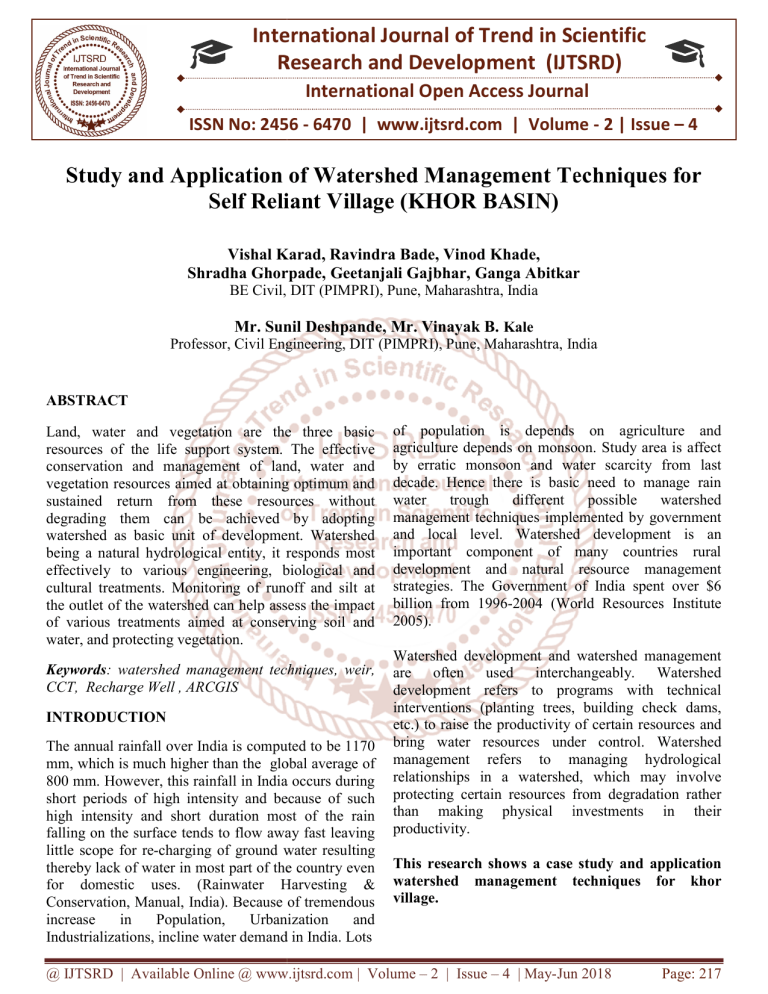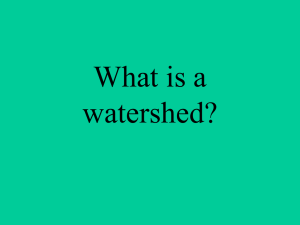
International Journal of Trend in Scientific
Research and Development (IJTSRD)
International Open Access Journal
ISSN No: 2456 - 6470 | www.ijtsrd.com | Volume - 2 | Issue – 4
Study and Application
pplication of Watershed Management Techniques
echniques for
Self Reliant
eliant Village (KHOR BASIN)
Vishal Karad
Karad, Ravindra Bade, Vinod Khade,
Shradha Ghorpade, Geetanjali Gajbhar, Ganga Abitkar
BE Civil, DIT (PIMPRI), Pune, Maharashtra, India
Mr. Sunil Deshpande, Mr. Vinayak B. Kale
Professor, Civil Engineering
Engineering, DIT (PIMPRI), Pune, Maharashtra, India
ABSTRACT
Land, water and vegetation are the three basic
resources of the life support system. The effective
conservation and management of land, water and
vegetation resources aimed at obtaining optimum and
sustained
ned return from these resources without
degrading them can be achieved by adopting
watershed as basic unit of development. Watershed
being a natural hydrological entity, it responds most
effectively to various engineering, biological and
cultural treatments.
s. Monitoring of runoff and silt at
the outlet of the watershed can help assess the impact
of various treatments aimed at conserving soil and
water, and protecting vegetation.
Keywords: watershed management techniques
techniques, weir,
CCT, Recharge Well , ARCGIS
INTRODUCTION
The annual rainfall
infall over India is computed to be 1170
mm, which is much higher than the global average of
800 mm. However, this rainfall in India occurs during
short periods of high intensity and because of such
high intensity and short duration most of the rain
falling on the surface tends to flow away fast leaving
little scope for re-charging
ng of ground water resulting
thereby lack of water in most part of the country even
for domestic uses. (Rainwater Harvesting &
Conservation, Manual, India). Because of tremendous
increase
in
Population,
Urbanization
and
Industrializations, incline water demand
mand in India. Lots
of population is depends on agriculture and
agriculture depends on monsoon. Study area is affect
by erratic monsoon and water scarcity from last
decade. Hence there is basic need to manage rain
water
trough
different
possible
watershed
management techniques implemented by government
and local level. Watershed development is an
important component of many countries rural
development and natural resource management
strategies. The Government of India spent over $6
billion from 1996-2004 (World
orld Resources Institute
2005).
Watershed development and watershed management
are often used interchangeably. Watershed
development refers to programs with technical
interventions (planting trees, building check dams,
etc.) to raise the productivity of certain
ce
resources and
bring water resources under control. Watershed
management refers to managing hydrological
relationships in a watershed, which may involve
protecting certain resources from degradation rather
than making physical investments in their
productivity.
This research shows a case study and application
watershed management techniques for khor
village.
@ IJTSRD | Available Online @ www.ijtsrd.com | Volume – 2 | Issue – 4 | May-Jun
Jun 2018
Page: 217
International Journal of Trend in Scientific Research and Development (IJTSRD) ISSN: 2456-6470
Study AreaStudy area lies in Pune District and surrounding area
of Khor Villages in Daund taluka. The Latitudinal
extension is 18 24’22.38’’ North to 74 44’21.78’’
North and Longitudinal extension is 750 4’ 92” East
to 750 7’ 50” East. rises near Dombewadi village.
The total basin area is 11.97 sq.km.
METHODOLOGY
Methodology which is adopted this study technical
watershed development guidelines are used which is
given by Soil Conservation and Agriculture
Department, Government of Maharashtra and
Ministry of Rural Development, Government of India.
All river and Tributaries are digitized from S.O.I.
toposheets. Terrain maps are made by ASTER data
which is downloaded from BHUVAN website and
calculations of runoff and discharge theoretically and
by ARCGIS software and further use it in the design
purpose of watershed management structures.
Figure.2 watersheds surrounding to khor watershed
Site Selection Criteria for Water Harvesting
StructureTo overcome water scarcity of study area various
watershed management structures are proposed in
hilly, plateau and lower reach in khor watershed i.e.
continuous contour Trenches, check dams, weir and
recharge wells.
Figure.3 Slope Map of khor watershed
Figure.1 Digital Elevation Model of watershed
Figure.4 streams in khor watershed
@ IJTSRD | Available Online @ www.ijtsrd.com | Volume – 2 | Issue – 4 | May-Jun 2018
Page: 218
International Journal of Trend in Scientific Research and Development (IJTSRD) ISSN: 2456-6470
2456
Figure.5 location of watershed outlet
DESIGN CRIETERIA FOR WATERSHED
MANAGEMENT
STRUCTURES
TO
BE
PROPOSED:
rise behind the weir and then flow over it. if the jet of
liquid passes over the weir springs free as it leaves the
upstream face then the weir is known as sharp crested
weir. Where the upstream floor level and the crest
level are not the same, the crest may be provided flat
at the top with a width of about 2 m. An upstream
slope of 2 : 1 to 3 : 1 shall be given depending on site
conditions. For major projects, it is advisable to
undertake model studies for obtaining the best shape
for the crest. For weirs without shutters, the crest level
shall be at the required pond level. For weirs with
falling shutters, the crest level shall not be lower than
2 m below the elevation of the pond as the maximum
height of the falling shutters is normally limited to 2
m. It maybe suitably raised if possible, from
consideration
nsideration of passing the design flood discharge at
the desired afflux and with the waterway provided. If
the lowest crest level fixed in the above manner
causes too much of afflux, the waterway of weir may
be suitably increased.
1. Continuous Contour Trenches:
Figure.7 weir
Figure.6 Continuous Contour Trenches
Continuous Contour trench (CCT) is a trench dug
along a contour line. CCTs are constructed in the
ridge area, basically located in upper reaches of a
micro watershed. This structure checks soil erosion,
slowing down the velocity of runoff and improves soil
moisture profile. (i) For this structure 5.71 to 14.04
degree slope area is suitable. (ii) Iff the slope is more
than 14.04 degrees, one can’t be dug contour trenches
because of digging in high slope causes soil erosion.
(iii) If the slope is less than 5.71 degrees, other
structures other than contour trenches and CCT are
best for such place (Govt.. of India, 2007).
2. Weir :
It is a standard device for measurement of flow in
open channel since last two centuries. It is an
obstruction in the path of flow that causes the liquid to
3. Check Dams :
(i) Earthen or cement check dams can be constructed
across bigger first order or second order streams. (ii)
It should be constructed in areas of gentle slopes (less
than 1.72 degrees). (iii) Depth of nala should be more
than 1 m. (iv) The soil downstream of
o the bund should
not prone to water logging. (v) Vertical distance
between two check dams should be more than 1 m.
(vi) It can be constructed in area having mix material.
Figure.8 Check dam
@ IJTSRD | Available Online @ www.ijtsrd.com | Volume – 2 | Issue – 4 | May-Jun
Jun 2018
Page: 219
International Journal of Trend in Scientific Research and Development (IJTSRD) ISSN: 2456-6470
4. Recharge well :
Artificial recharge wells are engineered systems
where surface water is put on or in ground for
infiltration and subsequent movement to aquifer to
augment ton groundwater resource. Other objectives
of recharge well is to reduce land subsidence. The
main advantage of recharge well is that they are
inexpensive relative to other methods.the general
dimensions for rainfall ranging from 600 mm to 900
mm are 3 feet diameter and depth 20 feet for every
1000 sq.m. each well can recharge 2500 lit/day to
1000 lit/day depending upon rainfall.
Figure.9 Recharge well
Morphometric Analysis of khor watershed :
1
2
3
4
5
6
7
8
9
10
11
12
13
14
15
16
17
No. of stream order
Catchment length (km)
Catchment Area (sq. km)
Basin Relief (m)
Perimeter (km)
High Height (m)
Low Height (m)
Relative Relief (m)
Bifurcation Ratio
Length Ratio
Basin Stream length(km)
Drainage Density (km/sq. km)
Stream Frequency (sq.km)
Circularity Ratio
Elongation Ratio
Length of overland flow
Form Factor ratio
Table.1
5
8.97
11.96
155
21.575
690
535
17.27
0.833
1.38
17.36
1.50
1.92
0.322
0.294
0.75
0.272
The Morphometric analysis is important in any
hydrological
investigation like assessment of
groundwater
potential
,Ground
management,
pedology
and
environmental
assessment.
Geomorphologists and hydrologists have recognized
that certain relations are most important between
runoff characteristics, and geographic and geomorphic
characteristics of drainage basin systems. Various
important hydrologic phenomena can be correlated
with the physiographic characteristics of drainage
basins such as shape, size, slope of drainage area,
drainage density, length and size of the contributories
etc. Morphometric analysis helps to understand
relationship between basin area and topography of
region that allows how we deals with natural system
basically for land use e.g. water harvesting techniques
applies on particular watershed.
CONCLUSION
Whatever water is getting to the area by rainfall it is
enough for basic needs of human activities, yet also
lost of area faces water scarcity problem in India. In
case of Morphometry of this river has 5th stream
order with drainage length of 1053.04 Km.
Bifurcation Ratio has indicated this area having
hydrological and geological control. Shape of basin is
elongated it means this river has flow very short
period in monsoon and most of period is dry even
there large number of tributaries are there. According
to texture ratio and length ratio there is lots of erosion
and soil loss, which control by continuous contour
trenches. Morphological and geohydrological units
are helpful for water harvesting. According to them 2
weir , 50 Continuous contour trenches(with bore holes
of 0.5ft. diameter and 30ft. deep) and 10 recharge
wells are suggested in study area.
REFRENCES
1) Pandurang D. Jankar 1 and Dr.Mrs.Sushma S.
Kulkarni, “Watershed Management - A Case
Study Of Madgyal Village”, International Journal
of Engineering Research & Technology (IJERT),
Vol. 2 Issue 7, July –( 2013).
2) Patil,
Shivraj
G,
Wayal,
AbhaykumarS,”Watershed Management in Rural
Area –A Case Study”,International Journal of
Scientific Engineering and Research (IJSER),
Volume 1, Issue 1.(2013)
3) Mrs.
Vidula
Arun
Dr.Mrs.SushmaShekharKulkarni,”
management – A Means of
@ IJTSRD | Available Online @ www.ijtsrd.com | Volume – 2 | Issue – 4 | May-Jun 2018
Swami,
watershed
sustainable
Page: 220
International Journal of Trend in Scientific Research and Development (IJTSRD) ISSN: 2456-6470
Development - a case study”, international journal
of engineering science and technology
(IJEST),(2011).
8) Dr. Arun B Patil and Nanda M Vibhute Watershed
management for Kari River Basin a tributary of
Sina River Maharashtra (IJAR) 2017
4) Mr.Nittin
Johnson,Mr Govindaradjane
T.
Sundrajan
“Impact
of
watershed
management on the ground water and irrigation
potential – a case study (IJEST)(2013)
9) Mr.Ajaykumar Kadam , Dr.R.N.Sankha ,Dr
Bhavana
N.
Umarikar
Assessment
of
Groundwater Potential Zones using GIS
Technique: acase studyof shivganga river basin
pune Maharashtra (conference paper)(2016)
5) Ms.RadhikaPatil,Profhandargekar
P.A.
“watershed management in sangave village’’
(2015)(IJSRD)
6) Mr.ParagThakre ,Mr.RajA.Jadhav “watershed
management a case study of tanda village”
(2013)(IJITEE)(Volume 3 issue 4 )
10) S.Modak
.M.K.Verma.
Mrs.C.P.Devatha
Application Of Arc Gis For Estimation Of Basin
Potential ‘‘A Case Study - Kharun River
Basin’’.(IJERT) (2012).
7) Mrs.V.A.Swami, Mrs.S.S.Kulkarni, Mr.Akshay R.
Thorwate “water and soil conservation through
simple techinques” (2011) (IJEST)
@ IJTSRD | Available Online @ www.ijtsrd.com | Volume – 2 | Issue – 4 | May-Jun 2018
Page: 221




